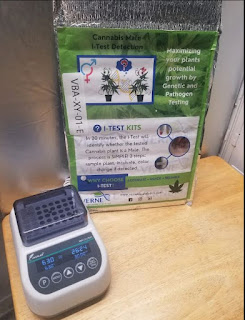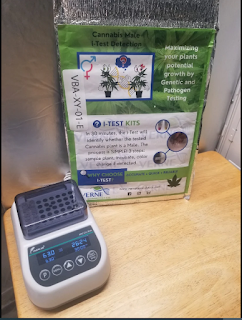3 Important HLVd Prevention Techniques Hop Latent Viroid (HLVd or HLV) | Verne Bioanalytics
The HLVD increases once again in certain areas of the United States, and every cannabis farmer should be adhering to essential HLVd prophylactic methods in order to save their crops and their income.
Hop Latent Viroid: What Is It?
Cannabis plants become sick because of the infectious virus HLV that can be identified by HLVD Testing. It was initially identified in hop plants many years ago, and it first became apparent in cannabis plants in the 2010s. In a California cannabis growing facility, the virus was formally established as the cause of stunting in 2019. (i.e., dudding disease).
HLVd is a silent killer since it may remain dormant in cannabis plants for a very long period without showing any signs at all because it is a latent viroid. Fast forward to 2021, and HLVd has become a significant issue for cannabis farmers in the US and Canada that was on the verge of a catastrophe and HLVD Testing is the solution.
In your grow facility, how does HLVD spread?
Mechanical transmission and infected clone transfer are the two main ways that HLVd spreads. Let's examine each transmission technique in more detail.
Mechanical Transfer
The term "mechanical transmission" of HLVd refers to touching someone who has the virus. Cannabis plants may get infected with HLVd when an HLVd-infected item contacts them, passing the virus from the object to the plant.
Tools and equipment, including pruning tools, cutting equipment, and even pots used for growing and transplanting cannabis plants, are the most prevalent mechanical means by which HLVd is transferred to cannabis plants. HLVd may spread to an uninfected plant, for instance, if you prune an infected plant and then prune an uninfected plant using the same equipment.
Transmission of Infected Clone
When clones from an infected mother plant are introduced into your grow facility, infected clone transmission occurs. Clones from infected mothers often have reduced success rates at establishing roots, but if they do, 10–30% of your plants may die from HLVd.
What Happens If You Have HLVd in Your Cannabis Plants?
HLVd may seriously affect your plants and income with no visible early warning symptoms that can be confirmed by HLVD Testing. Common signs of the viroid emerging from latency include:
Height and leaf size increase at a slower rate.
Less flowers in mass
Looser and smaller buds
Broken stems
Irregular branching
Deformities in leaves
The chlorosis of leaves
Lower trichome and resin levels
Decreased output of oil
Decreased vigor
Smaller leaves and closer-spaced internodes in the vegetative state
Quality and yields will suffer if your plants are infected with HLVd, which will eventually lead to a decrease in sales. 90% of the participating cultivation sites tested positive for HLVd, according to research done by Dark Heart Laboratory with 100 Californian cannabis farmers between August 2018 and July 2021.
Analysts in the cannabis business predicted at the time that more over 30% of all cannabis plants are impacted by HLVd. If farmers don't take action to stop it before it starts, HLVd might cost the cannabis business billions of dollars each year.
What You Can Do to Avoid HLVd in Your Grow Facility
Sadly, HLVd is a latent virus that may exist for a very long period before any symptoms appear. Additionally, eradicating HLVd from your facility is neither fast nor simple. The greatest approach to safeguard your plants and your profits is via prevention.
To prevent HLVd out of your grow facility, use the 3 S's:
1. Sanitation
You must thoroughly clean any tools, equipment, and other items that could come into contact with plants since this is the most typical method that HLVd is spread. Use a 10% bleach solution (i.e., 1 part bleach to 9 parts water) as opposed to standard sanitation solutions since they won't eradicate HLVd.
The use of containers, which might spread HLVd to your cannabis plants, should also be avoided. Use single-use grow bags instead to enhance hygiene and lower transmission.
For instance, you may convert to single-use, inexpensive grow bags, which come in a variety of sizes and provide your grow operation other advantages in addition to cleanliness, such as:
Cut down on labor expenses
Spend less on containers
Make it unnecessary to wash and store pots
No need for equipment or potting machines
Simple to assemble and transfer pH-balanced and buffered
No need for a pre-soaking
Uncompressed means there is no waiting time, no need to spend time hydrating, and better consistency
Drainage openings
Micro-perforated all throughout for improved airflow and oxygen to the root zone.
2. Systems
Make sure you're taking precautions to stop the introduction or spread of HLVd at your facility by reviewing your procedures and SOPs. Make sure, for instance, that you have processes in place to:
isolation of newly brought in clones
Plants quarantined for infection
Create control zones all across your facility.
Make sure to thoroughly clean everything that comes into touch with plants.
Keep a supply of seeds, clones, and tissue culture offsite.
3. Screening
HLVD Testing is essential to safeguard your plants against the spread of HLVd since it is a latent viroid. You should at the very least conduct comprehensive screenings often, including:
Test newly arrived clones at the facility
Before you clone, test your mother plants.
You regularly test plants at your facility.
Visually screen and regularly check plants for HLVd signs.
Important Lessons About HLVd Prevention for Cannabis Growers
The most effective treatment for HLVd is prevention. You don't want this virus to enter your facility since it has the potential to be deadly. Therefore, adhere to the following three essential preventive practices: properly sanitize, create and implement preventative systems, and screen often.
Additionally, think about switching to clean living soil grow bags to lower the risk of HLVd transmission and increase the quality and productivity of your plants. To start today, get in touch with us!




Comments
Post a Comment